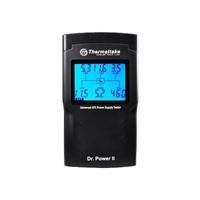
- Supports all ATX power supply up to ATX12V 2.3.
- Oversized LCD panel shows all voltages within 1/10th volt for quick and easy troubleshooting.
- Voltage reading for all rails (+12V/5V/+3.3V/5VSB/-12V)
- Built-in output connectors diagnostic system, low-voltage, high-voltage, no voltage, PG alarms.
- Built-in alarm to notify user of unstable or abnormal power supply activity.
- Easy to use troubleshooting system will quickly identify if power supply is the source of instability.
Construction was disappointing, other reviews gave me the impression that this was well-built and rock-solid. My unit was moderately flimsy, felt cheap (flexed and creaked when inserting/removing the motherboard power harness and used cheap power connectors that don't prevent cables from being connected incorrectly). I doubt that this unit would survive in a commercial high-use environment environment but would be better suited for hobbiests.
Bottom line is that this thing works but with a good dosage of care. I could easily have fried it the first time I used it if I hadn't taken a close look at the connector keys.This is made by Thermaltake who, in my opinion, is no stranger to power supplies and other PC components.
The box feels sturdy and comfortable in my hand. The LCD is nice and bright and easy to read. The instructions are well written and easy to understand.
To use this thing, you basically:
remove AC power from power supply
plug in the main 20 or 24 pin lead from power supply to bottom of tester
plug in additional rails to test, such as pci-e (2/4), old fashioned molex, cpu rail (2/4) or sata power
provide AC power to power supply
hit the button on the tester to power up the power supply and press again to cycle thru the different rails
the LCD is blue if all is well and turns red and beeps if all isn't well
at the end of the tests it turns the power supply back off
you can also hold the button to automatically test each connected rail for 5 seconds
I have tested about 4 power supplies so far and found one bad one. The nice thing about the LCD is that it shows you the voltage reading as well as what it should be right next to it. Easy identification of what you are looking at/testing.
The only concern I have is that I don't think this particular tester puts the power supply under load. I think this could be an important test. And of course this won't tell you if your power supply is overloaded you should be able to figure that out on your own. But it certainly is a nice and easy (and professional looking) way to test a power supply.
I would recommend.I have a couple of older testers that have led indicators only. This device provides much more detailed information. I build and repair PC's and having more detailed information is critical to getting my work done. If you are a frequent builder or need to test a supply, this can be a great asset. It is a bit expensive compared to the cost of purchasing a new supply so getting the less expensive tester will probably give you as much information as you could want. The ability to cycle through the different connections is a big asset and will help me get the warranty work done quicker by letting the manufacturer/supplier know what is wrong so I don't have to waste my time going through their paces.it does what it is suppose to do, i can't be any happier. i don't like to be forced into adding additional words to my statement.As a computer consultant I often run into power supplies that either don't work or are intermittent. I had various ways of testing them prior to getting this tester but nothing was satisfactory. I tested dozens of supposedly defective Power supplies that I had kept around as they had passed my old tester and this device confirmed for me that the supplies were all defective in different ways. Very quick hookup and test.


No comments:
Post a Comment